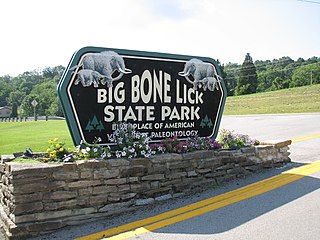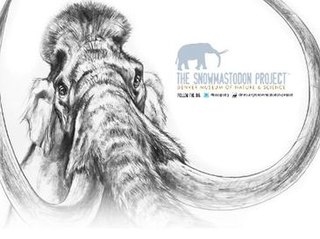Related Research Articles

A mastodon is a member of the genus Mammut, which, strictly defined, was endemic to North America and lived from the late Miocene to the early Holocene. Mastodons belong to the order Proboscidea, the same order as elephants and mammoths. Mammut is the type genus of the extinct family Mammutidae, which diverged from the ancestors of modern elephants at least 27-25 million years ago, during the Oligocene.

Big Bone Lick State Park is located at Big Bone in Boone County, Kentucky. The name of the park comes from the Pleistocene megafauna fossils found there. Mammoths are believed to have been drawn to this location by a salt lick deposited around the sulfur springs. Other animals including forms of bison, caribou, deer, elk, horse, mastodon, musk ox, peccary, ground sloths, wolves, black bears, stag moose, saber-toothed cats, and possibly tapir also grazed the vegetation and salty earth around the springs that the animals relied on for their diet.

The Santa Barbara Museum of Natural History is a natural history museum in Santa Barbara, California.

The Museum of the Earth is a natural history museum located in Ithaca, New York. The museum was opened in 2003 as part of the Paleontological Research Institution (PRI), an independent organization pursuing research and education in the history of the Earth and its life. Both PRI and the Museum of the Earth are formally affiliated with Cornell University. The Museum of the Earth is home to Earth science exhibits and science-related art displays with a focus on the concurrent evolution of the Earth and life.

The Hiscock Site is an archaeological and paleobiological site in Byron, New York, United States that has yielded many mastodon and paleo-Indian artifacts, as well as the remains of flora and fauna not previously known to have inhabited Western New York during the late Pleistocene. Now owned by the Buffalo Museum of Science, it has been studied by archeological excavation and analysis since 1983.
Burnet Cave is an important archaeological and paleontological site located in Eddy County, New Mexico, United States within the Guadalupe Mountains about 26 miles west of Carlsbad.

The Manis Mastodon site is a 2-acre (1 ha) archaeological site on the Olympic Peninsula near Sequim, Washington, United States, discovered in 1977. During the 1977-78 excavation, the remains of an American mastodon were recovered with a 13,800-year-old projectile point made of the bone from a different mastodon embedded in its rib. The site was placed on the National Register of Historic Places in 1978.
The Coats–Hines–Litchy site is a paleontological site located in Williamson County, Tennessee, in the Southeastern United States. The site was formerly believed to be archaeological, and identified as one of only a very few locations in Eastern North America containing evidence of Paleoindian hunting of late Pleistocene proboscideans. Excavations at the site have yielded portions of four mastodon skeletons, including portions of one previously described as being in direct association with Paleoindian stone tools. The results of excavations have been published in Tennessee Conservationist, and the scholarly journals Current Research in the Pleistocene, Tennessee Archaeology, and Quaternary Science Reviews. The site was listed on the National Register of Historic Places on July 12, 2011.

Paul Schultz Martin was an American geoscientist at the University of Arizona who developed the theory that the Pleistocene extinction of large mammals worldwide was caused by overhunting by humans. Martin's work bridged the fields of ecology, anthropology, geosciences, and paleontology.

Timothy H. Heaton is a professor of earth sciences at The University of South Dakota (USD), Vermillion, specializing in archaeological geology. Much of Heaton's work is focused on the Great Basin as well as on forming chronologies for the extinction of many Ice Age animals. He is most widely known for his work at On Your Knees Cave located in Prince of Wales Island in southeast Alaska where early humans remains ca. 10,300 years old were found. This find is one of the oldest human genetic samples recovered in the Americas. The site record further supports the possibility the first people into the Americas south of the ice sheets traveled along the Alaskan coast by boat rather than overland through central Canada. He also discovered a new species of fossil skunk (Brachyprotoma) at Crystal Ball Cave, Utah.

The Snowmastodon site, also known as the Ziegler Reservoir fossil site, is the location of an important Ice Age fossil excavation near Snowmass Village, Colorado. Fossils were first discovered on October 14, 2010, during the construction of a 5 hectares reservoir to supply Snowmass Village with water. Over the subsequent weeks, after an agreement had been reached to allow paleontological excavation, crews from the Denver Museum of Nature & Science and the U.S. Geological Survey worked along with the construction crews as more fossil material was uncovered. The site closed for five months over the winter, reopening May 15, 2011. Between May 15 and July 4, 2011, crews from the Denver Museum of Nature & Science conducted a large scale fossil excavation alongside construction crews building a dam for the reservoir. In total over 36,000 vertebrate fossils, more than 100 species of fossil invertebrates and over 100 species of fossil plants were found in sediments deposited by an alpine lake during the last interglacial period.

The Dent site is a Clovis culture site located in Weld County, Colorado, near Milliken, Colorado. It provided evidence that humans and mammoths co-existed in the Americas. The site is located on an alluvial fan alongside the South Platte River.
Dick "Sir Mammoth" Mol is a Dutch paleontologist - a specialist in the field of mammoths for almost three decades. He is a research associate of several museums. Mol's primary focus is on mammals of the Quaternary period, including mammoths and extinct rhinoceros species.
C. Malcolm Watkins (1911–2001) was an American historian, archaeologist, and curator. He researched early American material culture, with a specific interest in the decorative arts. Watkins served as a head curator of the Department of Cultural History at the National Museum of American History at the Smithsonian Institution in Washington, D.C. He spent a total of 31 years working at the Smithsonian.

Paleontology in New York refers to paleontological research occurring within or conducted by people from the U.S. state of New York. New York has a very rich fossil record, especially from the Devonian. However, a gap in this record spans most of the Mesozoic and early Cenozoic.

Paleontology in the United States refers to paleontological research occurring within or conducted by people from the United States. Paleontologists have found that at the start of the Paleozoic era, what is now "North" America was actually in the southern hemisphere. Marine life flourished in the country's many seas. Later the seas were largely replaced by swamps, home to amphibians and early reptiles. When the continents had assembled into Pangaea drier conditions prevailed. The evolutionary precursors to mammals dominated the country until a mass extinction event ended their reign.

Geology Hall is a historic building on the Queens Campus of Rutgers University, in New Brunswick, New Jersey. It was built from April 1871 to June 1872 to house various science classes and the Rutgers Geology Museum. The museum was established in 1872 by George Hammell Cook, Rutgers' then professor of geology, with a collection of specimens whose assembly began in the 1830s under Cook's predecessor, Lewis Caleb Beck. As classes and offices moved out of the hall, the museum expanded until it occupied the entire hall by the mid-20th century. In 1973, the hall was added to the New Jersey and National Register of Historic Places (NRHP) with Old Queens, President's House, Van Nest Hall, Daniel S. Schanck Observatory, the Kirkpatrick Chapel, and Winants Hall as part of the Old Queens Campus historic district.

Kirk R. Johnson is an American paleontologist, author, curator, and museum administrator, and is currently serving as Sant Director of Smithsonian's National Museum of Natural History.
Daniel Fisher is a paleontologist who studies paleobiology and the extinction of mastodons. He received his Ph.D. in Geological Sciences from Harvard University in 1975 and is the Claude W. Hibbard Collegiate Professor of Paleontology and the Director of the Museum of Paleontology at the University of Michigan. His research on mammoth tusks has helped to shape the common understanding of mammoth life.
References
- 1 2 Buffalo Museum of Science – Dr Laub
- ↑ Journey to the Ice Age: Discovering an Ancient World by Peter L. Storck, 2004, p. 221-2
- ↑ Conservation of the California Condor
- ↑ FOXNews.com - Tuberculosis May Have Helped Bring Down Mastodons - Science News | Science & Technology | Technology News
- ↑ Mastodons Driven to Extinction by Tuberculosis, Fossils Suggest
- ↑ Tuberculosis Helped Bring Down Mastodons | LiveScience
- ↑ news.nationalgeographic.com/news/2006/10/061003-mastodons.html